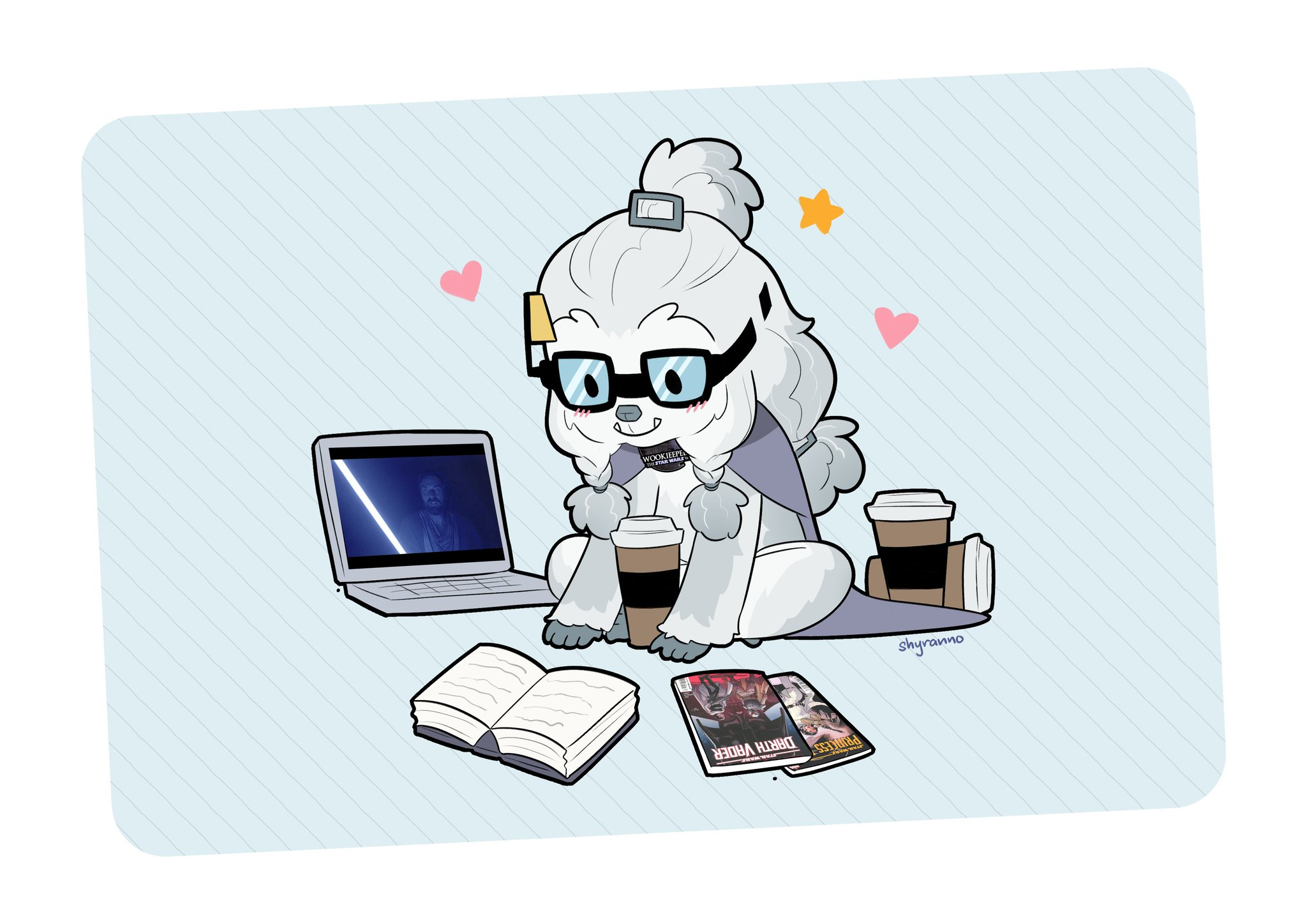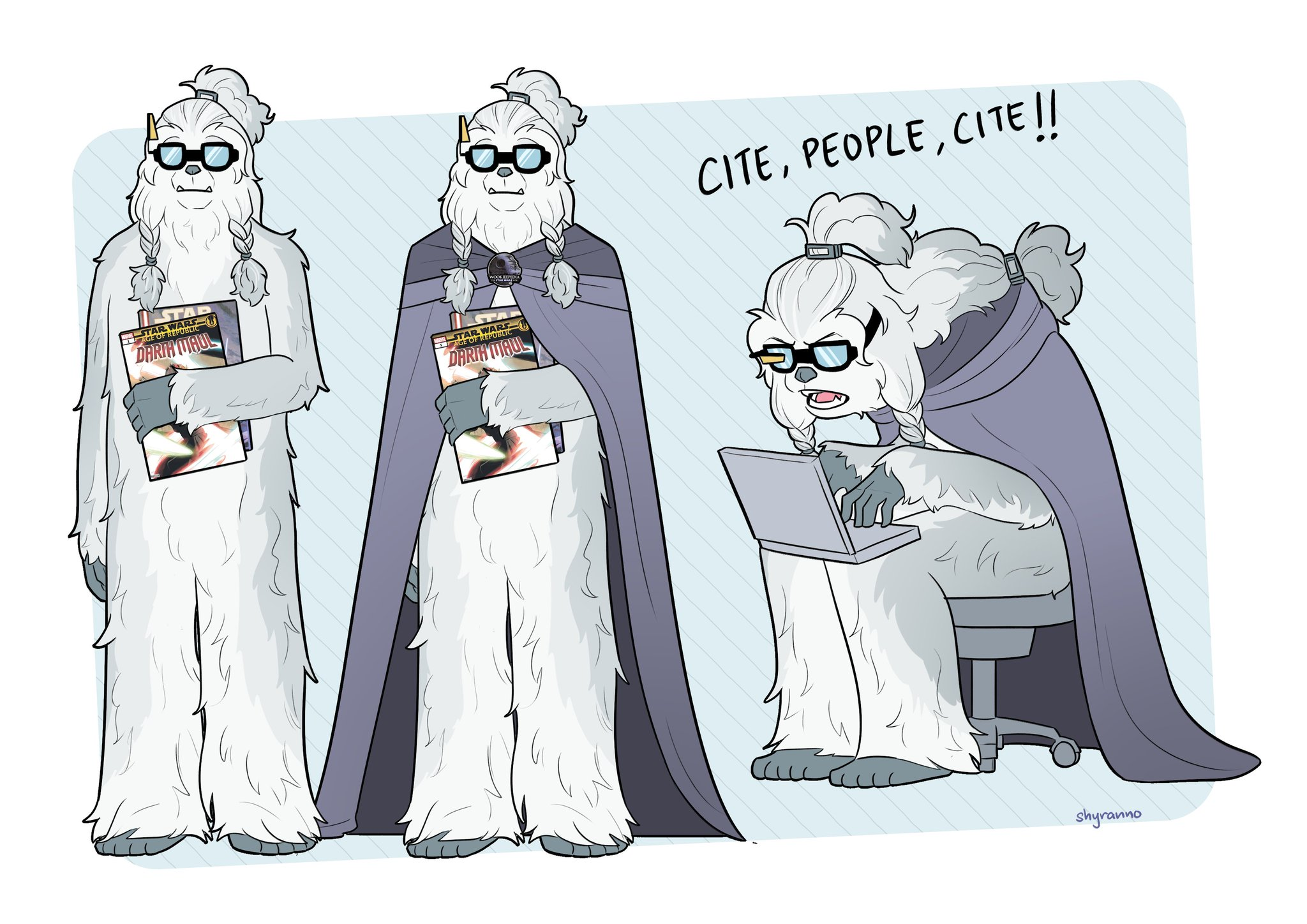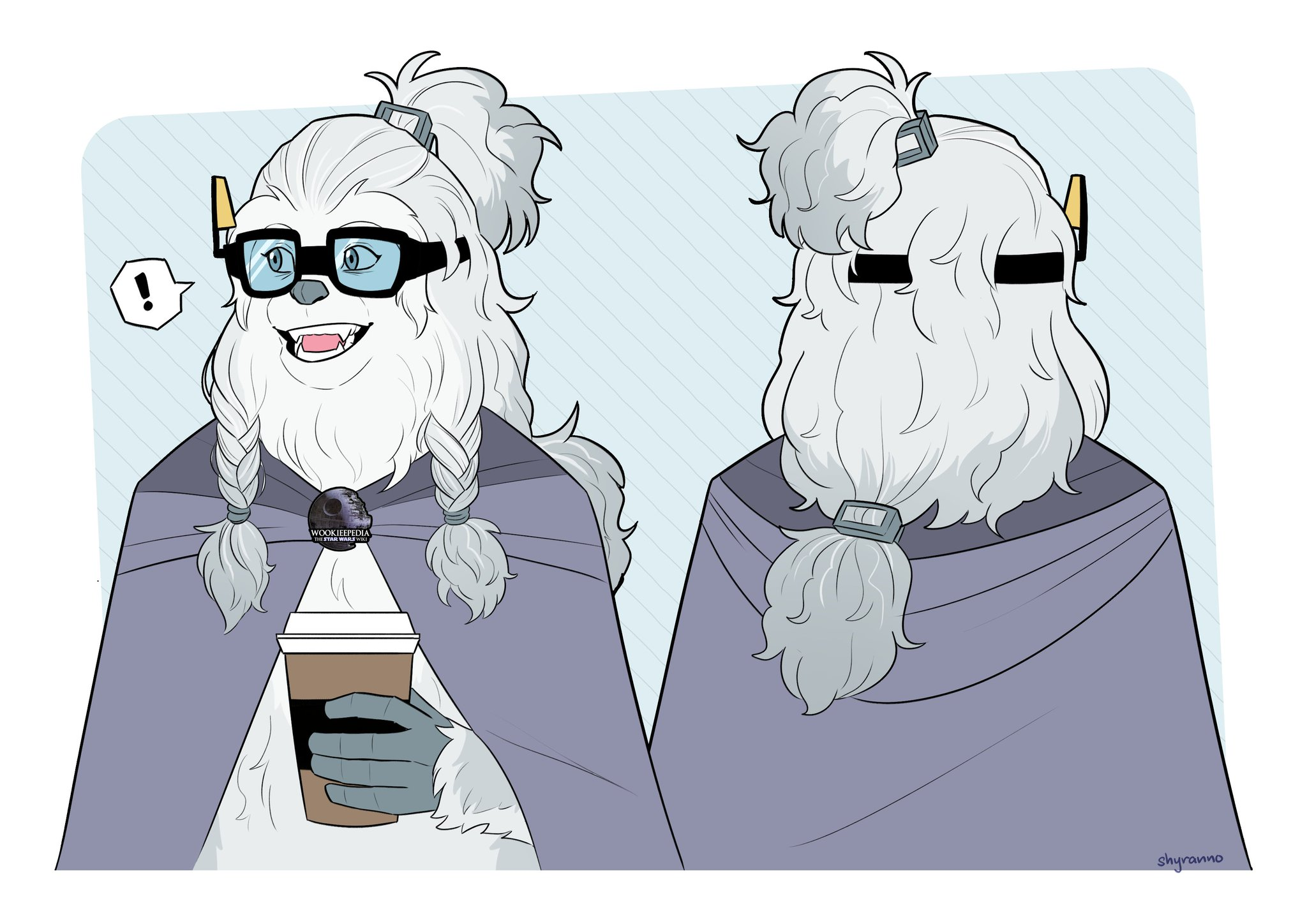We know editing can seem daunting at first. "There's no way I have anything to add to this wiki. It has everything!" "I know nothing about wikitext!" "I'm worried my edits will get reverted or I'll break something!" We all had these concerns before jumping in, but you have an advantage many of us didn't: this tutorial! On this page, we'll go over some of the more common questions and concerns regarding editing on the wiki, focusing on the experience of someone who is editing a wiki for their first time. If you already feel familiar with everything on this page, please see the Knight tutorial to continue your journey with more advanced features and techniques.

Your typical Wookieepedian doing their research
Many people just assume Wookieepedia has everything there is to know about Star Wars, and so they see no reason to even try adding anything. This couldn't be further from the truth. There are thousands of articles in need of updates, cleanup, expansion, improved citation, images, and so much more. There are even thousands of articles that still need to be created! The Star Wars universe is massive, and it's unlikely that Wookieepedia will ever have every single piece of lore in its database. There's always room for improvement!
New editors also often get intimidated due to a presumed lack of personal knowledge or Star Wars reference material. Nobody knows everything there is to know. If all you have is one book, it's almost guaranteed that there is something in the book that is missing from the wiki. Most editors prefer to focus on specific topics that they are very familiar with instead of attempting to tackle the entirety of lore. If you're having trouble finding missing information on the wiki, narrow the site down to one topic you're familiar with (for example, Star Wars: Knights of the Old Republic, Star Wars: The Clone Wars, the sequel trilogy, Star Wars: The New Jedi Order, or Star Wars: Galaxy's Edge).
If at the end of the day you still don't see anything new you can add, then feel free to fix typos and grammatical and spelling errors! This helps the wiki appear more professional, which is the goal! Just remember that, per the Manual of Style, all in-universe Wookieepedia articles are written in past tense and from an in-universe perspective. Our articles are meant to act as if they exist in a database within the Star Wars galaxy, excluding the "Behind the scenes" section. An archivist in the Jedi Temple wouldn't be mentioning real-world information from Earth in their databank entries, would they?
We won't lie, the wikitext coding can be the most daunting part of editing at first, but very few of us had ever seen any coding at all before joining Wookieepedia. We all learned as we went! Here we'll go over some of the basics of editing an article's code, such as adding links, section headers, categories, and more.
Text on a wiki can be both bolded and italicized. In order to bold text, such as is required for the first mention of an article's main topic in its introduction, simply place three apostrophes on either side of the text you want to be bold, like so:
This produces the following: Anakin Skywalker.
To italicize text, such as with the names of starships, simply use two apostrophes on either side, like so:
This produces the following: Millennium Falcon.
You can combine the two to create text that is both bold and italicized, like so:
This produces the following: Millennium Falcon.
Links help readers navigate the wiki, taking them from one article to another related article with one click. It's important that articles link to everything topic mentioned in the text so that readers can easily access information. Thankfully, links are very simple to make. Let's use the sentence "Anakin Skywalker had a lightsaber." There are two topics here that should be linked: Anakin Skywalker, and Anakin Skywalker's first lightsaber. For the first link, all you need to do is add two brackets on either side of the text:
This produces the following: Anakin Skywalker had a lightsaber.
This links to the article with the title "Anakin Skywalker." However, when we link "lightsaber," we want it to take readers to the article on Anakin's first lightsaber, not the general lightsaber article. In order to link to an article with a title that is different than the text we're using for the link, we create what's called a pipelink. To do this, you simply add a bar between the article title and the text you want to appear.
This produces the following: Anakin Skywalker had a lightsaber.
A single topic is usually going to be mentioned more than once in an article. It is unnecessary to link to that topic's article every time it is mentioned. Therefore, we only link to an article on the first mention of the topic in the introduction (the opening paragraph(s)), body (which is all the prose in the sections following the introduction), infobox (the box at the top right of an article that gives quick facts about the main topic), and the references (the citations that are listed at the bottom of the article). Any further linking creates what we call "duplicate links," which are excessive.
Articles are divided into sections per the Layout Guide. This makes finding information in an article easier, as it prevents readers from having to read an entire article to find a specific fact. Sections can also contain subsections for further division of the text. Main sections are created by placing two "equals" marks on either side of the section title, like so:
To divide the "History" section into subsections, simply add a third "equals" sign on either side of the subsection title, like so:
This can be even further divided, though be mindful that it's generally best to have two paragraphs in each section, so be mindful of over-sectioning. To create further subsections, follow the same pattern of adding "equals" signs, like so:
The "Appearances" and "Sources" sections of articles list every piece of official Star Wars media that the article's topic is mentioned or appears in. The easiest way to tell what goes in each section is by dividing media into two categories: narrative and informative. "Appearances" lists narrative works, such as films, video games, novels, comics, and television episodes. "Sources" lists reference material, such as encyclopedias, documentaries, Databank entries, Essential Guides, and magazines.
To add an item to an "Appearances" or "Sources" list, simply add a bullet point followed by a link to the article for the piece of media. For "Appearances," items are listed in in-universe chronological order. For "Sources," items are listed in real-world release order. Below is an example of how to add a novel to a list of appearances:
This produces the following (notice that book titles are italicized):
- The High Republic: Light of the Jedi
If this novel is the first time the subject has made an appearance in any Star Wars media, add {{1st}} after the link, like so:
This produces the following:
- The High Republic: Light of the Jedi
If the subject is first mentioned in a piece of media, such as in dialogue, but is not actually present in the story, and has not appeared in any other media prior, it instead gets the following tag: {{1stm}}. This produces the following:
- The High Republic: Light of the Jedi

Make sure to cite your sources for any information you add!
All information on Wookieepedia should be cited to an official source, per the sourcing policy. The only place where citations, more commonly referred to as "references," aren't to be used is in the introductory prose of an article, unless the article has no introduction (this happens with articles that are too short to have sections). Let's say you want to cite a piece of information to the video game Star Wars Jedi: Fallen Order. In order to create a reference, simply place the following code at the end of the information that you are citing:
This produces a small number in brackets, as seen here: Cal Kestis was a Padawan.
This should only be used for the first instance of the reference. If you need to cite multiple things throughout an article to the same source, simply use the following code for every subsequent reference:
While there must be a citation at the end of every paragraph, multiple sentences can use a single citation. Lastly, make sure there is a section at the bottom of the article, directly after the "Appearances" and "Sources" sections, titled "Notes and references" and that it has the {{Reflist}} template, as follows:
All articles are required to be in at least one category. Categories help readers find other articles tangentially related to a topic, all grouped into a list on a single page. To add a category to an article, simply place the following at the bottom of the article's code:
This places the article in the category Outer Rim Territories planets. Keep in mind that categories themselves are also placed into categories. For instance, "Category:Outer Rim Territories planets" is itself within Category:Planets by region, which is within Category:Planets. Because of this, an article on a planet in the Outer Rim wouldn't need to be in all three categories. Simply placing it in "Category:Outer Rim Territories planets" will suffice.

How you'll feel after your first few edits stick
Not to worry, if you accidentally break something, it can easily be undone in seconds. If you would like to test edits out before saving them to an article, you can use the sandbox here for experimenting. You can even click here to create your own personal workbench under the title "User:/Workbench," where you can test and experiment free of worry! If you're editing an article and want to see what your changes will look like before clicking the "Save changes" button, you can click the "Show preview" button next to it. We recommend doing this before saving any edit, regardless of how experienced you are.
In the event that your edit to an article does get reverted, do not worry. If your edit was made in good faith, simply find your edit in the recent changes log, and the person who reverted it should have left an edit summary explaining why it was reverted. They may also leave you a message on your talk page explaining what you did wrong. So long as you are respectful and act in good faith, fellow editors will work with you to help you improve. Administrators only block editors who intentionally disrupt the wiki or refuse to listen to advice or heed warnings. If you want to contact other editors quickly for help, we recommend joining the Wookieepedia Discord server!